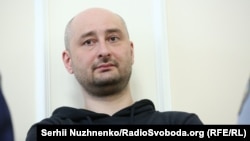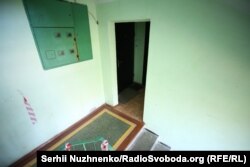The killing of Arkady Babchenko did not happen.
But you’d certainly be forgiven if, in the hours after the first reports emerged late on May 29, you had glimpsed a photograph of his body lying face down in a pool of blood and concluded that this was proof that another Russian reporter had been murdered.
Тhe photograph was fake, seemingly part of the elaborate hoax that Ukrainian security officials said was concocted to thwart a murder plot against Babchenko.
Who actually took and staged the shot is not known. It's not even certain that it's Babchenko in the photo. But how it came to light and circulated in the hours after the fake killing was reported is a key element of a law enforcement sting that enlisted a former journalist, a Ukrainian lawmaker, and possibly many others.
The photo was first published on the Facebook page of a former Ukrainian reporter who says he now works for a shadowy consultancy organization based in the Washington, D.C., area.
It quickly circulated among Ukrainian and Russian reporters -- though few, if any, media outlets chose to publish it, mainly due to its gory content.
Yevhen Lauer, the reporter who published the photo along with a caption reading “Damn It, Bitches,” told RFE/RL late on May 29 that he received it from a law enforcement source, whom he declined to identify.
Lauer, who has worked for various Ukrainian media outlets in the past, has more recently been affiliated with Trident Group LLC. Based in the Washington suburb of Arlington, the company says it specializes “in law enforcement, investigations, intelligence gathering and analysis, conflict prevention and conflict resolution, international risk control, executive protection and special operations.”
The company’s president, Yuri Koshkin, confirmed to RFE/RL that Lauer had done work for Trident but said he knew nothing of Lauer’s involvement with the SBU sting operation to nab Babchenko’s would-be killers.
RFE/RL also declined to publish the photograph when it first appeared, not only for the bloody content but also because of concerns about its sourcing.
Additional questions were raised about its timing since Ukrainian officials, including a lawmaker, had said that Babchenko had died in an ambulance on the way to the hospital, suggesting he was still alive when the photo was taken.
In a posting to Facebook, the lawmaker, Anton Herashchenko, defended the secrecy, and the deception, of the SBU, which he said “was done to avoid even the slightest possibility of information leaking.”
“It was for this reason that a photo of the alleged victim Arkady Babchenko was made,” he wrote.
On May 30, after Babchenko appeared at a news conference and Ukraine’s main security agency, the SBU, revealed a sting operation to arrest the alleged plotter, Lauer declined to answer further questions about his involvement, responding only with a text message of smiley face emojis.
He did not respond to further messages sent via Facebook.
While Ukrainian officials insisted that the operation succeeded in both preventing Babchenko’s killing and uncovering the involvement of Russian intelligence agencies, the hoax more broadly was condemned by many press advocates, who worried about undermining the credibility of both law enforcement agencies and media organizations.
“All it takes is one case like this to cast doubt on all the other political assassinations," Christophe Deloire of the organization Reporters Without Borders said in a statement.
And the faked photograph was already being used by at least one pro-Russia Twitter user on May 30, who made the argument that other photographs could now not be trusted – for example, the so-called White Helmet rescuers who aid civilians in war-torn Syria.
“Ukraine just owned the whole journalism, from now on never trust emotional articles and photos,” the user, identified as Antikaratel, wrote.
In remarks to reporters, and postings to social media, Babchenko, who fled to Ukraine after receiving death threats in Russia, made no specific comments about the photograph. But he apologized to his wife for what he had put her through and praised SBU officers for their work.
And in a posting to Twitter later, Babchenko made clear his opinion of the Russian government.
“I’ve promised to die when I’m 96, having danced on Putin’s grave and taking a selfie while standing on an Abrams [tank] on Tverskoi Boulevard” in Moscow, he wrote. “I will try to do this.”














